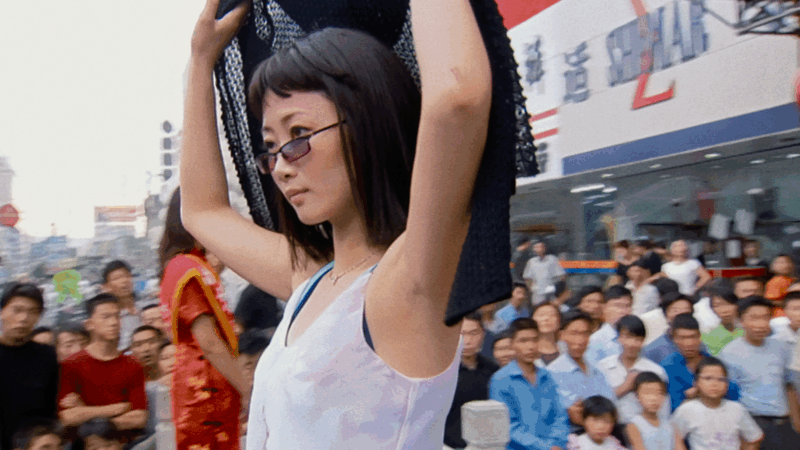‘Caught by the Tides’ turns discarded documentary scraps into a remarkable drama
During the pandemic, the Chinese director Jia Zhangke, like many of us, had a lot of time on his hands. He began sifting through a personal archive consisting of footage that he had shot since 2001. He ended up weaving much of this footage — some of which we’ve seen before — into a gorgeous and lyrical feature, called Caught by the Tides.
We’re used to seeing archival material in documentaries, but this film is something far rarer and stranger: It’s an archival drama — an entire narrative composed from two decades’ worth of discarded scraps.
The movie uses this unfamiliar method to tell a familiar Jia story, about a passionate and tough-minded woman, played by the great Zhao Tao, the director’s frequent collaborator and off-screen wife. Over several years, this character, whose name is Qiaoqiao, experiences romance and heartbreak and winds up adrift, traveling a 21st-century Chinese landscape that is forever in flux. This flux has become the great subject of Jia’s career; he’s deeply attuned to the winds of social, economic, political, technological and even geographical change sweeping through his country.
Caught by the Tides unfolds in three acts. The first takes place in Datong, a city in northern China. Jia’s fans will recognize scenes from Unknown Pleasures, his 2002 drama about aimless youth in a town where the local coal-mining industry is on the decline and capitalism is on the rise.
Qiaoqiao is a young dancer who entertains in bars and clubs, and also at promotional events for a liquor brand. Every time she dances, Jia unleashes a torrent of music, most infectiously with the 1998 hit “Butterfly,” by the Swedish pop group Smile.dk.
Jia has always used music vividly in his films, and in Caught by the Tides, he strings together so many free-form scenes of people singing and dancing that the movie almost plays like a full-blown musical. It’s ragged and disorienting, but that’s the point; the future and even the present seem almost bursting with possibility.
It’s around this time that Qiaoqiao falls in love with a local gangster named Bin, played by the actor Li Zhubin. But their romance swiftly goes sour and the two separate, which sets the stage for the movie’s more melancholy second act.
Qiaoqiao heads south, sailing down the Yangtze River and searching for Bin; he resurfaces at one point, but what they once had is now lost forever. Meanwhile, we witness the staggering human toll of the Three Gorges Dam project, which has led to mass displacement and demolition of homes in the region.
Jia has an uncanny ability to capture the big picture along with the small, to move from an intimate, character-focused drama to a more expansive, panoramic one. With each shift in perspective, we’re reminded that every person uprooted here has a story to tell.
Much of the second-act footage comes from Jia’s 2008 film, Still Life, and his 2019 drama, Ash Is Purest White. More than a decade separates those two movies, and Jia doesn’t bother to hide the seams as he toggles between them.
One of the most captivating things about Caught by the Tides is that the images and formats change over time, from grainy film stock and low-grade digital video early on to smoother HD video and even some virtual-reality footage in the later sections. Jia has showed us before how China and the larger world are being transformed; here, he shows us that the motion-picture medium itself is continually evolving.
In the third act, Qiaoqiao briefly reunites in Datong with Bin, who’s now visibly aged. This section was shot in 2022, under tight COVID protocols, and Jia uses it to capture a mood of present-day alienation: He shows us influencers shooting their TikToks and friendly robots roaming the aisles of grocery stores.
But Jia never loses sight of our heroine, or the extraordinary actor playing her. Through the entire film, Zhao Tao never says a word — a bold choice that perhaps made it easier for the director to shape a narrative out of the raw material. Zhao doesn’t need the dialogue; she has the radiance and emotional eloquence of a silent film star.
By the close of Caught by the Tides, Qiaoqiao isn’t dancing anymore; she’s jogging at night with several other women and men. The scene plays like a tribute from Jia Zhangke to his fellow Chinese citizens — a deeply moving culmination of all that they’ve endured that holds out hope as they run bravely into the future.
Transcript:
TONYA MOSLEY, HOST:
This is FRESH AIR. Our film critic Justin Chang says the documentary drama hybrid “Caught By The Tides” is one of the best and most unusual new movies he’s seen this year. It’s the latest from the acclaimed Chinese filmmaker Jia Zhangke, and it draws from footage that he began shooting in 2001 to tell a story of two lovers who separate and reunite over roughly two decades. The film is now in select theaters, and here is Justin’s review.
JUSTIN CHANG, BYLINE: During the pandemic, the Chinese director Jia Zhangke, like many of us, had a lot of time on his hands. He began sifting through a personal archive, consisting of footage that he had shot since 2001. He ended up weaving much of this footage, some of which we’ve seen before, into a gorgeous and lyrical feature called “Caught By The Tides.” We’re used to seeing archival material in documentaries, but this film is something far rarer and stranger. It’s an archival drama, an entire narrative composed from two decades’ worth of discarded scraps.
The movie uses this unfamiliar method to tell a familiar Jia story about a passionate and tough-minded woman, played by the great Zhao Tao, the director’s frequent collaborator and off-screen wife. Over several years, this character, whose name is Qiao Qiao, experiences romance and heartbreak and winds up adrift, traveling a 21st century Chinese landscape that is forever in flux. This flux has become the great subject of Jia’s career. He’s deeply attuned to the winds of social, economic, political, technological and even geographical change sweeping through his country.
“Caught By The Tides” unfolds in three acts. The first takes place in Datong, a city in northern China. Jia’s fans will recognize scenes from “Unknown Pleasures,” his 2002 drama about aimless youth in a town where the local coal-mining industry is on the decline and capitalism is on the rise. Qiaoqiao is a young dancer who entertains in bars and clubs and also at promotional events for a liquor brand. Every time she dances, Jia unleashes a torrent of music, most infectiously with the 1998 hit “Butterfly” by the Swedish pop group Smile.dk.
(SOUNDBITE OF SONG, “BUTTERFLY”)
SMILEDK: (Singing) Ay, ay, ay, I’m your little butterfly. Green, black and blue, make the colors in the sky. Ay, ay, ay, I’m your little butterfly. Green, black and blue, make the colors in the sky.
CHANG: Jia has always used music vividly in his films, and in “Caught By The Tides,” he strings together so many free-form scenes of people singing and dancing that the movie almost plays like a full-blown musical. It’s ragged and disorienting, but that’s the point. The future and even the present seem almost bursting with possibility.
It’s around this time that Qiaoqiao falls in love with a local gangster named Bin, played by the actor Li Zhubin. But their romance swiftly goes sour, and the two separate, which sets the stage for the movie’s more melancholy second act. Qiaoqiao heads south, sailing down the Yangtze River and searching for Bin. He resurfaces at one point, but what they once had is now lost forever. Meanwhile, we witness the staggering human toll of the Three Gorges Dam project, which has led to mass displacement and demolition of homes in the region.
Jia has an uncanny ability to capture the big picture along with the small, to move from an intimate, character-focused drama to a more expansive, panoramic one. With each shift in perspective, we’re reminded that every person uprooted here has a story to tell. Much of the second-act footage comes from Jia’s 2008 film, “Still Life,” and his 2019 drama, “Ash Is Purest White.” More than a decade separates those two movies, and Jia doesn’t bother to hide the seams as he toggles between them.
One of the most captivating things about “Caught By The Tides” is that the images and formats change over time, from grainy film stock and low-grade digital video early on to smoother HD video and even some virtual-reality footage in the later sections. Jia has showed us before how China and the larger world are being transformed. Here, he shows us that the motion-picture medium itself is continually evolving.
In the third act, Qiaoqiao briefly reunites in Datong with Bin, who’s now visibly aged. This section was shot in 2022, under tight COVID protocols, and Jia uses it to capture a mood of present-day alienation. He shows us influencers shooting their TikToks and friendly robots roaming the aisles of grocery stores. But Jia never loses sight of our heroine or the extraordinary actor playing her. Through the entire film, Zhao Tao never says a word, a bold choice that perhaps made it easier for the director to shape a narrative out of the raw material. Zhao doesn’t need the dialogue. She has the radiance and emotional eloquence of a silent film star.
By the close of “Caught By The Tides,” Qiaoqiao isn’t dancing anymore. She’s jogging at night with several other women and men. The scene plays like a tribute from Jia Zhangke to his fellow Chinese citizens, a deeply moving culmination of all that they’ve endured that holds out hope as they run bravely into the future.
MOSLEY: Justin Chang is a film critic for The New Yorker. If you’d like to catch up on interviews you’ve missed, like our conversation with Danny McBride about how he’s built a unique comedy empire blending sharp satire with Southern charm or Ramy Youssef about his new animated series, “#1 Happy Family USA,” check out our podcast. You’ll find lots of FRESH AIR interviews. And to find out what’s happening behind the scenes of our show and get our producers’ recommendations on what to watch, read and listen to, subscribe to our free newsletter at whyy.org/freshair.
FRESH AIR’s executive producer is Danny Miller. Our technical director and engineer is Audrey Bentham. Our managing producer is Sam Briger. Our interviews and reviews are produced and edited by Phyllis Myers, Roberta Shorrock, Ann Marie Baldonado, Lauren Krenzel, Therese Madden, Monique Nazareth, Susan Nyakundi and Anna Bauman. Our digital media producer is Molly Seavy-Nesper. Thea Chaloner directed today’s show. With Terry Gross, I’m Tonya Mosley.
(SOUNDBITE OF ARETHA FRANKLIN SONG, “TRY MATTY’S”)
Light from satellites will ruin majority of some space telescope images, study says
Astronomers have long been concerned about reflections from satellites showing up in images taken by telescopes and other scientific instruments.
Defense Department is reviewing boat strike video for possible release, Hegseth says
In a speech on Saturday, Defense Secretary Pete Hegseth defended the strikes, saying: "President Trump can and will take decisive military action as he sees fit to defend our nation's interests."
Bama, Miami in, Notre Dame out and Indiana No. 1 in College Football Playoff rankings
Nobody paying attention for the past 24 months would be surprised to see Indiana – yes, Indiana – leading the way into this year's College Football Playoff.
McLaren’s Lando Norris wins first F1 title at season-ending Abu Dhabi Grand Prix
Red Bull driver and defending champion Max Verstappen won the race with Norris placing third, which allowed Norris to finish two points ahead of Verstappen in the season-long standings.
A ban on feeding pigeons ruffles lots of feathers in Mumbai
The pigeon population has exploded — a result of people feeding the birds. For some it's a holy duty and a way to connect to nature. Critics point to health risks tied to exposure to pigeon droppings.
UN humanitarian chief: world needs to ‘wake up’ and help stop violence in Sudan
The UN's top humanitarian and emergency relief official has told NPR that the lack of attention from world leaders to the war in Sudan is the "billion dollar question".








